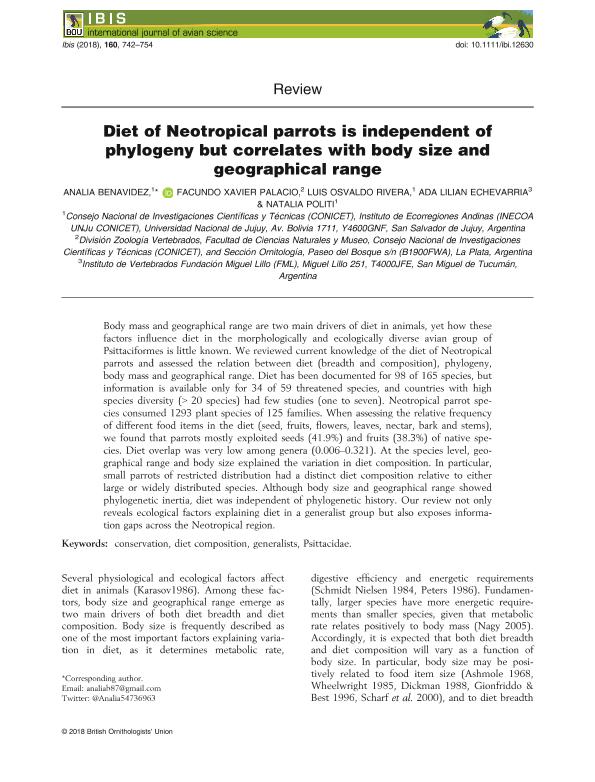Mostrar el registro sencillo del ítem
dc.contributor.author
Benavídez, Analía

dc.contributor.author
Palacio, Facundo Xavier

dc.contributor.author
Rivera, Luis Osvaldo

dc.contributor.author
Echevarria, Ada Lilian

dc.contributor.author
Politi, Natalia

dc.date.available
2019-11-29T21:07:00Z
dc.date.issued
2018-10
dc.identifier.citation
Benavídez, Analía; Palacio, Facundo Xavier; Rivera, Luis Osvaldo; Echevarria, Ada Lilian; Politi, Natalia; Diet of Neotropical parrots is independent of phylogeny but correlates with body size and geographical range; Wiley Blackwell Publishing, Inc; Ibis; 160; 4; 10-2018; 742-754
dc.identifier.issn
0019-1019
dc.identifier.uri
http://hdl.handle.net/11336/91040
dc.description.abstract
Body mass and geographical range are two main drivers of diet in animals, yet how these factors influence diet in the morphologically and ecologically diverse avian group of Psittaciformes is little known. We reviewed current knowledge of the diet of Neotropical parrots and assessed the relation between diet (breadth and composition), phylogeny, body mass and geographical range. Diet has been documented for 98 of 165 species, but information is available only for 34 of 59 threatened species, and countries with high species diversity (> 20 species) had few studies (one to seven). Neotropical parrot species consumed 1293 plant species of 125 families. When assessing the relative frequency of different food items in the diet (seed, fruits, flowers, leaves, nectar, bark and stems), we found that parrots mostly exploited seeds (41.9%) and fruits (38.3%) of native species. Diet overlap was very low among genera (0.006–0.321). At the species level, geographical range and body size explained the variation in diet composition. In particular, small parrots of restricted distribution had a distinct diet composition relative to either large or widely distributed species. Although body size and geographical range showed phylogenetic inertia, diet was independent of phylogenetic history. Our review not only reveals ecological factors explaining diet in a generalist group but also exposes information gaps across the Neotropical region.
dc.format
application/pdf
dc.language.iso
eng
dc.publisher
Wiley Blackwell Publishing, Inc

dc.rights
info:eu-repo/semantics/openAccess
dc.rights.uri
https://creativecommons.org/licenses/by-nc-sa/2.5/ar/
dc.subject
CONSERVATION
dc.subject
DIET COMPOSITION
dc.subject
GENERALISTS
dc.subject
PSITTACIDAE
dc.subject.classification
Otras Ciencias Agrícolas

dc.subject.classification
Otras Ciencias Agrícolas

dc.subject.classification
CIENCIAS AGRÍCOLAS

dc.title
Diet of Neotropical parrots is independent of phylogeny but correlates with body size and geographical range
dc.type
info:eu-repo/semantics/article
dc.type
info:ar-repo/semantics/artículo
dc.type
info:eu-repo/semantics/publishedVersion
dc.date.updated
2019-10-17T16:30:24Z
dc.journal.volume
160
dc.journal.number
4
dc.journal.pagination
742-754
dc.journal.pais
Reino Unido

dc.journal.ciudad
Londres
dc.description.fil
Fil: Benavídez, Analía. Universidad Nacional de Jujuy. Instituto de Ecorregiones Andinas. Consejo Nacional de Investigaciones Científicas y Técnicas. Centro Científico Tecnológico Conicet - Salta. Instituto de Ecorregiones Andinas; Argentina
dc.description.fil
Fil: Palacio, Facundo Xavier. Consejo Nacional de Investigaciones Científicas y Técnicas; Argentina. Universidad Nacional de La Plata. Facultad de Ciencias Naturales y Museo. Departamento Científico Zoología Vertebrados; Argentina
dc.description.fil
Fil: Rivera, Luis Osvaldo. Universidad Nacional de Jujuy. Instituto de Ecorregiones Andinas. Consejo Nacional de Investigaciones Científicas y Técnicas. Centro Científico Tecnológico Conicet - Salta. Instituto de Ecorregiones Andinas; Argentina
dc.description.fil
Fil: Echevarria, Ada Lilian. Fundacion Miguel Lillo. Direccion de Zoologia. Instituto de Vertebrados; Argentina
dc.description.fil
Fil: Politi, Natalia. Universidad Nacional de Jujuy. Instituto de Ecorregiones Andinas. Consejo Nacional de Investigaciones Científicas y Técnicas. Centro Científico Tecnológico Conicet - Salta. Instituto de Ecorregiones Andinas; Argentina
dc.journal.title
Ibis

dc.relation.alternativeid
info:eu-repo/semantics/altIdentifier/doi/https://doi.org/10.1111/ibi.12630
dc.relation.alternativeid
info:eu-repo/semantics/altIdentifier/url/https://onlinelibrary.wiley.com/doi/full/10.1111/ibi.12630
dc.relation.alternativeid
info:eu-repo/semantics/altIdentifier/url/https://onlinelibrary.wiley.com/doi/pdfdirect/10.1111/ibi.12630
Archivos asociados
